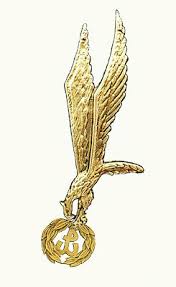Why „Cichociemni”?
Origin of the name
The origin of the name of the ”Cichociemni” formation, the Silent Unseen Paratroopers of Home Army (Cichociemni Spadochroniarze Armii Krajowej), is not entirely clear. It is possible that the name is related to the way of recruiting candidates for Cichociemni, because of the way they disappeared from the units quietly at night, not informing anyone. Another theory is that the name was associated with the quiet and invisible operation of the Home Army paratroopers and their method of secretive transfer to the occupied country. An interesting theory is presented by Alexander Grobicki in his book „Soldier Sikorski”, where the autor claims that the name of the formation comes from the definition of the detonator. The mentioned element was a long aluminum tube, filled with chemical substances. The participants of the special operations course used it for doing pranks. The igniter used to be crashed noiselessly and in the dark, and the rest of the „fun” worked of its own. The participants of the course called this element of sappers equipment „Cichociemny”. Officially, the name of the formation appeared for the first time in the instructions of Branch VI in September 1941. During the war, the paratroopers of the Home Army were also often referred to as birds or jumpers.
Paratrooper badge
A distinguishing feature of the Cichociemni became the Paratrooper Badge, established by the order of the Supreme Commander (Naczelny Wódz – NW), GEN Władysław Sikorski, on June 20, 1941. The badge depicted the eagle falling into battle. Two types of badges had been established, combat and regular. The combat badge differed from the ordinary in that the eagle had a golden beak and talons. It is assumed that the idea of introducing the badge was born in the heads of two officers, later Cichociemni – captains Jan Górski and Maciej Kalenkiewicz. The graphic artist Marian Walentynowicz is considered the author of the design.
Parashute badges were given to soldiers trained in parachute centers in Great Britain and later also in Italy. They were soldiers of the Parachute Brigade, Cichociemni and political couriers to serve in the occupied country, Polish paratroopers dropped to other countries of occupied Europe as part of Special Operations Executive and Office of Strategic Services, and finally foreigners trained on Polish parachute courses. On November 19, 1944, the Minister of National Defense rescinded the current Parachute badge, introducing a new one: from then onwards, a golden laurel wreath was to be added to the claws of the eagle from below. Each Paratrooper Mark had a stamped call on its back: TOBIE OJCZYZNO (To you the Fatherland) and another number. The first badges with numbers 1-500 were reserved for the Cichociemni. The wreath introduced in 1944 as the distinguishing feature of the battle badge had its own number stamped on the reverse. In total, at least 6,550 badges were made, of which 6252 badges were given, including 243 Frenchmen, 168 Norwegians, 70 Britons, 4 Dutch and Belgians, and 2 Americans and Czechs.
On February 5, 1954, the Parachute Mark of the Home Army was granted in London to the Cichociemni. A silver anchor of the „Fighting Poland” (Polska Walcząca) was added the laurel wreath of the Parachute Mark. At that time, a separate badge was not made – several Cichociemni added anchors to their war badges on their own. It was not until many years later that such badges were produced for veterans.
Tłumaczenie:
Jacek Gancarson

Znak spadochronowy
Armii Krajowej

